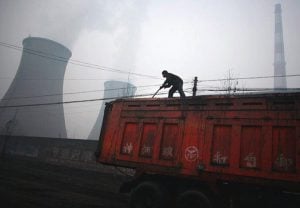China’s estimated total carbon dioxide emissions reached 25% of global emissions in 2011 and they continue to grow rapidly – so rapidly, in fact, that the increase in China’s emissions over an eight-month period is about the same as the UK’s total emissions in 2011.
As coal contributes two-thirds of primary energy supply and more than 80% of electricity generation in China, carbon capture and storage (CCS) is widely recognised as the most important technology to achieve a deep cut in CO2 emissions.
At the same time, China plays an important role in the cost reduction and development of key low-carbon technologies, as Ajay Gambhir has pointed out on China Dialogue.
China’s significantly lower labour costs, the abundant availability of skilled engineers and the relatively fast timeline in developing infrastructure projects, all have the potential to accelerate the uptake of CCS.
But there is not yet a large-scale integrated CCS project in operation or under construction in China. Rather, the country has only a scattering of pilot projects, such as Shenhua Group’s scheme in Ordos, Inner Mongolia, designed to capture and store 120,000 tonnes of CO2 per year, Huaneng’s 120,000 tonne per year capture pilot in Shanghai and China Power Investment’s 10,000 tonne per year capture pilot in Chongqing.
Industry blames the absence on financing and CO2 storage risks, plus the additional energy needed to run the technology, known as the “energy penalty”.
The Chinese government has committed to energy conservation and energy efficiency in its 12th five-year plans (2011-15), at both national and provincial level. Efficient use of coal has become a national priority as a result and a power dispatch policy designed to save energy is now widely implemented in the Chinese electricity system. Widely deploying CCS technologies would require a hike in the power sector’s energy consumption of around 20%.
Large-scale adoption of CCS – for example via a requirement that all new coal-fired power plants are fitted with CCS technology – is therefore considered incompatible with China’s energy efficiency and energy supply security priorities.
However, as we argue in a recent article in Environmental Science and Technology, CCS can provide benefits. Firstly, the technology could play a role as a “strategic virtual reserve” against extreme weather or supply interruption, and turning off CO2 capture in these circumstances would immediately reduce coal consumption for power generation by more than 20%.
Secondly, CCS could help decarbonise the transport sector and reduce the import of liquid fuel. And thirdly, power plants could adopt upgradable CCS technologies (such as changing to a more efficient solvent), which could result in the reduction in the energy penalty over the lifetime of the plant.
To address the challenge in the long term, climate security needs to be viewed as at least of equal importance to the energy security supply goal in the Chinese political agenda. With climate change higher up the priority list, de-politicising the whole issue of international energy investment and trading could rapidly speed up the deployment of CCS in China.
The Carbon Sequestration Leadership Forum (CSLF) – a ministerial level climate change initiative – and the International Energy Agency (IEA) could be potential platforms for dialogue on developing free trade and an energy investment environment that accelerates CCS development in China.
Another interesting political question to be explored is whether major industrialised countries would be prepared to use their political capital in international climate change negotiations to encourage China to speed up CCS deployment.
Bridging the financial gap
The estimated capital costs for developing large-scale CCS projects in China are significantly lower than in OECD countries. Compared to conventional coal-fired power plants, those with post-combustion CO2 capture, transportation and storage would require either a feed-in tariff of around 0.3 yuan (0.04 euros) per kilowatt hour or carbon price support of 40 euros per tonne of CO2 (the actual cost will be site specific) in the absence of any other targeted incentive mechanisms.
In other words, a 600-megawatt coal-fired power plant with full-scale CCS would require approximately 1.2 billion yuan (150 million euros) financial support per year throughout a 25 year lifespan or a 10 billion yuan (1.25 billion euros) initial one off payment at current discount rates.
The carbon market is often cited as the key to triggering large-scale CCS investment. China is experimenting with carbon emission trading schemes in seven provinces and cities, but the expected carbon price is unlikely to reach 40 euros per tonne of CO2 in the pilot emission trading stage.
In any case, even in a relatively mature emission trading scheme, such as Europe’s, the carbon price has proved to be insufficient to finance any low-carbon technologies in the power sector.
Given that CCS is not yet prioritised by the national government, it will not be feasible to rely solely on any one single measure to finance a large-scale CCS project in China in the short term. There had been hope that financial support would be given by foreign governments, but stakeholders in China have now started to recognise that it is unrealistic to rely on foreign governmental support or a single bilateral/multilateral programme to develop a large-scale CCS demonstration project in China.
CO2 storage risk
The long-term CO2 storage risks, including induced seismicity and release of the greenhouse gas into the atmosphere, are often cited as the major concerns by Chinese stakeholders. A number of projects in China have started to test CO2 injection, but there is still a lack of a regulatory framework and studies on risk mitigation and financial risk transfer for storage activities in China.
The lack of a regulatory framework for CO2 storage also means it is legally difficult to include CCS installations in Chinese emission trading schemes. As a result, emission reductions arising from CCS are currently not able to trade in China’s seven pilot carbon markets.
The European Parliament passed a CCS Directive in 2009 to regulate CO2 storage risk. It requires CO2 storage operators to surrender emission allowances for any emissions caused by leakage. Under Article 8 of the directive, CO2 storage operators in Europe have to demonstrate financial security before commencing CO2 injection activities and this article has created significant barriers for demonstrating CCS in EU countries.
The debate and discussion around the CO2 regulatory framework and risk sharing between operators and the state will crop up in China sooner or later. Most new technologies require a favourable risk-sharing framework between the state and the operator. Large-scale CO2 storage projects could face considerable delay if an implementable storage regulation and risk-sharing framework is not in place.
Environmental disputes and incidents of social unrest have grown in number in China in the last 15 years (at a rate of perhaps 30% per year according to Yang Chaofei, former chief of engineering in China’s Ministry of Environmental Protection). As this trend continues, public perception could become a major barrier in developing onshore CO2 transportation and storage projects.
As a significant proportion of stationary emission sources are along the coast in China, offshore CO2 storage in saline formation and depleted oil and gas fields would be important options for large-scale CCS developments. However, other than a few research projects in the South China Sea and Bohai Sea (such as the Guangdong CCS Readiness Project) there is no industrial initiative to develop offshore CO2 storage projects.
The large-scale deployment of CCS technologies in China ultimately requires that Chinese climate policy climbs the political agenda, so that carbon reduction is seen to be of equal importance to energy conservation and energy supply security goals. Without this, few early opportunities exist for triggering the development of a large-scale CCS demonstration project.
Importantly, the National Development and Reform Commission (NDRC) has recently issued its own guidance on promoting carbon capture, utilisation and storage, which focuses on six areas: developing pilot and demonstration projects along the technology chain; developing integrated demonstration projects; exploring and establishing financial incentive mechanisms; strengthening strategy and planning for development; promoting standards and regulation; and strengthening capacity building and international collaboration.
Current policies for deploying CCS technologies in Europe and the US remain ambiguous. However, if these markets became more attractive, it would be advantageous for Chinese energy companies and manufacturers to develop large-scale CCS projects within China for the purposes of technology learning and marketing, a strategy which would be perfectly aligned with China’s “industry upgrade” goal.
When we visited a Chinese power company recently, the project developers were formulating and considering options for a CCS ready design – which would make it easier to retrofit existing power plants with carbon capture – for investments in a new overseas coal-fired power plant, in order to hedge against potential climate policy risk.



